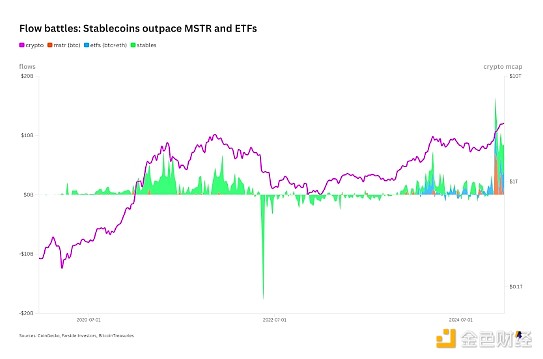
Author: David Canellis, Blockworks; Compiler: Tao Zhu, Golden Finance
As the debate rages over whether Saylor is a once-in-a-lifetime financial genius or just another over-leveraged trader, stablecoins is bringing more liquidity to cryptocurrencies.
At least, that's in terms of the raw dollar value being pumped into the space right now.
In the past two months alone, MSTR has spent $17.5 billion on Bitcoin, as shown in the orange area below. Most of the cash came from buyers of zero-interest convertible bonds.
MicroStrategy's purchases can simply be thought of as accepting dollars with one hand and exchanging them for Bitcoin with the other. Fast and cheap liquidity in exchange for risk exposure.
Over the same period, U.S. Bitcoin ETF net inflows increased by $16.5 billion. The ETH ETF saw a net increase of $3 billion, and these flows are shown in blue on the chart.
ETFs follow much the same process as MicroStrategy, but without the bonds. They use investors' cash to buy equal amounts of Bitcoin or Ethereum, passing the exposure onto shareholders, minus fees.
Stablecoins, MicroStrategy’s Bitcoin purchases and ETF inflows converged in November
Then there are stablecoins. Stablecoin issuers have minted a total of $30.8 billion in tokens since mid-October. More than 92% of the funds flowed to USDT and USDC.
With the exception of Sky’s USDS and the more exotic alternatives that have emerged (such as Ethena’s USDe and Usual’s USD0), stablecoin managers typically take U.S. dollars, purchase short-term Treasury bills and other cash equivalents, and then Issue an equal amount of new tokens to anyone who wires them cash.
Obviously, stablecoin flows are not actually the same cash pipeline as ETF inflows or MSTR.
But they do represent something similar: a common impulse to enter the cryptocurrency market through multiple routes.
Liquidity over the past nine weeks has reached nearly $68 billion – easily the largest wave of liquidity on record.











